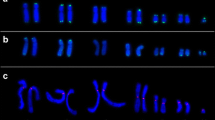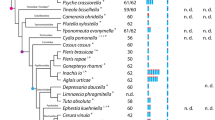Abstract
Zoo-fluorescence in situ hybridization (FISH) with human whole chromosome-specific paint probes revealed extensive homoeologies between Indian muntjac (2n=6, 7 female, male) and human karyotypes (2n=46). Forty-two conserved syntenic segments, corresponding to all human chromosomes except the Y chromosome, produced a near-complete coverage of the muntjac complement and revealed margins of interspecific segmental homoeology. To test the hypothesis that interstitial satellite DNA loci, illuminated by a Chinese muntjac C5-satellite probe in Indian muntjac chromosome arms, mark ancestral fusion points (Lin CC, Sasi R, Fan YS, Chen Z-Q (1991) New evidence for tandem chromosome fusions in the karyotypic evolution of the Asian muntjacs. Chromosoma 101: 19–24), we combined Zoo-FISH with C5 satellite mapping. Twenty-six interstitial satellite DNA loci were detected in the haploid Indian muntjac genome and were found to co-localize with the margins of conserved human/Indian muntjac syntenic segments. These results were confirmed by two-colour FISH and are in accordance with the tandem fusion hypothesis for Indian muntjac chromosomes. Furthermore, conserved syntenic segment combinations detected in pig, cattle and Indian muntjac Zoo-FISH maps reveal ancestral artiodactyl chromosomes.
Similar content being viewed by others
References
Arnason U, Gullberg A, Janke A, Xu X (1996) Pattern and timing of evolutionary divergences among hominoids based on analyses of complete mtDNAs. J Mol Evol 43: 650-661. Support for colour printing costs was kindly provided by Metasystems.
Bogenberger JM, Neitzel H, Fittler F (1987) A highly repetitive DNA component common to all Cervidae: its organization and chromosomal distribution during evolution. Chromosoma 95: 154-161.
Chowdhary BP, Frönicke L, Gustavsson I, Scherthan H (1996) Comparative analysis of the cattle and human genomes: detection of Zoo-FISH and gene mapping based chromosomal homologies. Mamm Genome 7: 297-302.
Collins C, Kuo WL, Segraves R, Fuscoe J, Pinkel D, Gray JW (1991) Construction and characterization of plasmid libraries enriched in sequences from single human chromosomes. Genomics 11: 997-1006.
Comings DE (1971) Heterochromatin of the Indian muntjac. Exp Cell Res 67: 441-460.
Elder FFB, Hsu TC (1988) Tandem fusions in the evolution of mammalian chromosomes. In: Sandberg AA, ed. The Cytogenetics of Mammalian Autosomal Rearrangements. New York: Alan R. Liss, pp 481-506.
Frönicke L, Chowdhary BP, Scherthan H, Gustavsson I (1996) A comparative map of the porcine and human genomes demonstrates Zoo-FISH and gene mapping based chromosomal homologies. Mamm Genome 7: 285-290.
Frönicke L, Müller-Navia J, Romanakis K, Scherthan H (1997a) Chromosomal homologies between human, harbor seal (Phoca vitulina) and the putative ancestral carnivore karyotype revealed by Zoo-FISH. Chromosoma (in press).
Frönicke L, Chowdhary BP, Scherthan H (1997b) Segmental homology between cattle (Bos taurus), Indian (Muntiacus muntjak vaginalis) and Chinese muntjac (M. reevesi) karyotypes. Cytogenet Cell Genet (in press).
Hayes H (1995) Chromosome painting with human chromosome specific DNA libraries reveals the extent and distribution of conserved segments in bovine chromosomes. Cytogenet Cell Genet 71: 168-174.
Holmquist GP, Dancis B (1979) Telomere replication, kinetochore organizers, and satellite DNA evolution. Proc Natl Acad Sci USA 76: 4566-4570.
Hsu TC, Pathak S, Chen, TR (1975) The possibility of latent centromeres and a proposed nomenclature system for total chromosome and whole arm translocation. Cytogenet Cell Genet 15: 41-49.
Hsu TC, Pathak S, Basen BM, Stahl GJ (1978) Induced Robertsonian fusions and tandem translocations in mammalian cell cultures. Cytogenet Cell Genet 21: 86-98.
Lan H, Wang W, Shi L (1995) Phylogeny of Muntiacus (Cervidae) based on mitochondrial DNA restriction maps. Biochem Genet 33: 377-389.
Lee C, Sasi R, Lin CC (1993) Interstitial localization of telomeric DNA sequences in the Indian muntjac chromosomes: further evidence for tandem chromosome fusions in the karyotypic evolution of the Asian muntjacs. Cytogenet Cell Genet 63: 156-159.
Levy HP, Schulz RA, Cohen MM (1992) Comparative gene mapping in the species Muntiacus muntiac. Cytogenet Cell Genet 61: 276-281.
Lin CC, Sasi R, Fan YS, Chen Z-Q (1991) New evidence for tandem chromosome fusions in the karyotypic evolution of the Asian muntjacs. Chromosoma 101: 19-24.
Miyamoto MM, Kraus F, Laipis PJ, Tanhauser SM, Webb DS (1993) Mitochondrial DNA phylogenies within Artiodactyla. In: Szalay F, Novacek MJ, McKenna MC, eds. Mammal Phylogeny: Placentals. Berlin: Springer, pp 268-281.
Neitzel H (1987) Chromosome evolution of Cervidae: karyotypic and molecular aspects. In: Obe G, Basler A, eds. Cytogenetics. Berlin: Springer, pp 91-112.
O'Brien SJ, Seuanez HN, Womack JE (1988) Mammalian genome organization: an evolutionary view. Annu Rev Genet 22: 323-351.
Raudsepp T, Frönicke L, Scherthan H, Gustavsson I, Chowdhary BP (1996) Zoo-FISH delineates conserved chromosomal segments in horse and man. Chrom Res 4: 218-225.
Rettenberger G, Klett C, Zechner U, Kunz J, Vogel W, Hameister H (1995a) Visualization of the conservation of synteny between humans and pigs by heterologous chromosomal painting. Genomics 26: 372-378.
Rettenberger, G., Klett, C, Zechner, U., et al. (1995b) Zoo-FISH analysis: cat and human karyotypes closely resemble the putative ancestral mammalian karyotype. Chrom Res 3: 479-486.
Saccone S, De Sario A, Della Valle G, Bernardi G (1992) The highest gene concentrations in the human genome are in telomeric bands of metaphase chromosomes. Proc Natl Acad Sci USA 89: 4913-4917.
Scherthan H (1990) The localization of the repetitive telomeric sequence (TTAGGG)n in two Muntjac species and implications for their karyotypic evolution. Cytogenet Cell Genet 53: 115-117.
Scherthan H (1995) Chromosome evolution in muntjac revealed by centromere, telomere and whole chromosome paint probes. In: Brandham PE, Bennet MD, eds. Kew Chromosome Conference IV. Kew: Royal Botanic Gardens, pp 267-281.
Scherthan H, Cremer T, Arnason U, Weier H-U, Lima-de-Faria A, Frönicke L (1994) Comparative chromosome painting discloses homologous segments in distantly related mammals. Nature Genet 6: 342-347.
Schmidtke J, Brennecke H, Schmid M, Neitzel H, Sperling K (1981) Evolution of Muntjac DNA. Chromosoma 84: 187-193.
Shi L, Yingying Y, Xingsheng D (1980) Comparative cytogenetic studies on the red muntjac, Chinese muntjac and their F1 hybrids. Cytogenet Cell Genet 26: 22-27.
Shows TB, Brown JA, Chapman VM (1976) Comparative gene mapping of HPRT, G6PD, and PGK in man, mouse, and muntjac deer. Cytogenet Cell Genet 16: 436-439.
Singer D, Downhower L (1979) Highly repeated DNA of the baboon: organization of sequences homologous to highly repeated DNA of the African green monkey. J Mol Biol 134: 835-842.
Solinas-Toldo S, Lengauer C, Fries R (1995) Comparative genome map of human and cattle. Genomics 27: 489-496.
Wurster DH, Benirschke K (1967) Chromosome studies in some deer, springbok and the pronghorn, with notes on placentation in deer. Cytologia 32: 273-285.
Wurster, DH, Benirschke K (1970) Indian Muntiacus muntjak, a deer with a low diploid chromosome number. Science 168: 1364-1366.
Yang F, Carter NP, Shi L, Ferguson-Smith MA (1995) A comparative study of karyotypes of muntjacs by chromosome painting. Chromosoma 103: 642-652.
Author information
Authors and Affiliations
Rights and permissions
About this article
Cite this article
Fro¨nicke, L., Scherthan, H. Zoo-fluorescence in situ hybridization analysis of human and Indian muntjac karyotypes (Muntiacus muntjak vaginalis) reveals satellite DNA clusters at the margins of conserved syntenic segments. Chromosome Res 5, 254–261 (1997). https://doi.org/10.1023/B:CHRO.0000032298.22346.46
Issue Date:
DOI: https://doi.org/10.1023/B:CHRO.0000032298.22346.46




